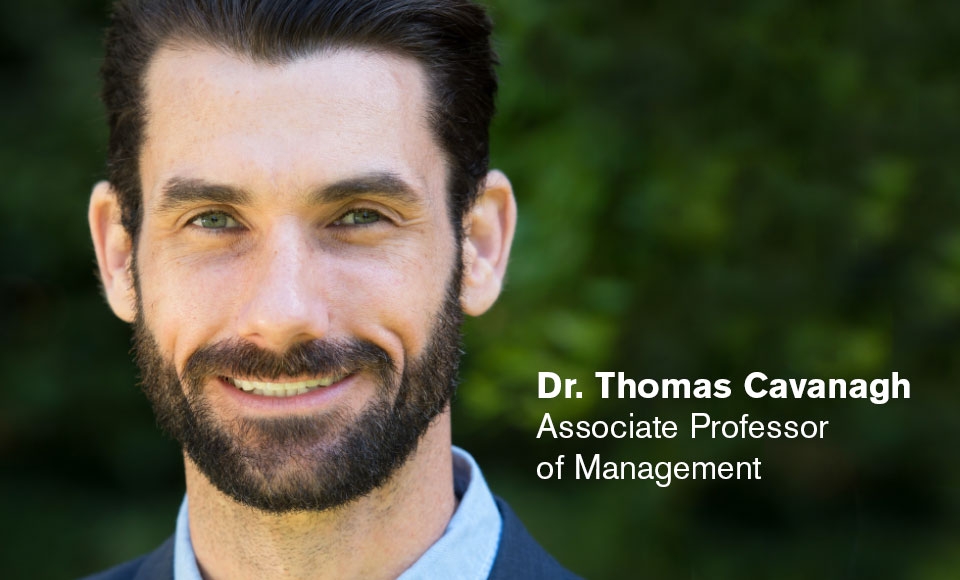Breadcrumbs
- News
- News Archive
- Business Students Welcome `Flipped Classroom' Approach

With a focus on distance learning during the pandemic, Dr. Thomas Cavanagh, associate professor of Management in the Barowsky School of Business, is receiving praise from his students for making the “flipped classroom” experience both engaging and effective.
“This approach advances student learning by giving students ample time to develop knowledge through in-class activities, receive feedback on their performance from their peers, and to develop their own judgment about a topic by providing feedback to their peers,” Cavanagh explains. “It also allows students to work at their own pace, and to review lectures as many times as necessary to understand them.”
Early in his teaching career Cavanagh, who earned his BA in Psychology from the University of Southern California and his MS and PhD in Organizational Psychology from Colorado State University, devoted a lot of time toward delivering lectures that included PowerPoint slides and personal stories to illustrate how class concepts could be applied to real life. At first, he received positive feedback, yet eventually noticed that many students lost interest in his lectures.
This prompted Cavanagh, whose research has focused on pedagogy, to examine other teaching approaches and that is when he discovered the “flipped” classroom design. In the traditional classroom, students listen to lectures during class time and then go home and complete assignments by themselves, or sometimes in teams. In the flipped classroom, students watch lecture materials before class, and then class time is spent engaging with the material in some way, such as discussion or activities.
“In the flipped classroom, facilitating student opportunities to actively engage in instructional material is the heart of the classroom experience,” Cavanagh says.
Dominic Olivo agrees. He has taken BUSX7202 MBA statistics prerequisite, MBA 5408 Exec Comms, and MBA 5404 Strategic Leadership for Org Performance with Cavanagh in the past year in the Barowsky School of Business’ MBA program.
“I really enjoyed his "flipped" classroom approach. His teaching methods were significantly more engaging in both the classroom and with remote learning. Having the ability to watch his video lectures in double-speed with annotations was the best way for me to learn while online,” Dominic says. “His concrete examples and group activities fit the agenda items wonderfully and enhanced the educational experience. I was really impressed with how effective his teaching methods are, especially with the transition to online learning.”
REQUEST INFORMATION ABOUT DOMINICAN'S UNDERGRADUATE PROGRAMS
While hundreds of Dominican students – and college students around the country – slowly adjusted and adapted to online learning via Zoom, Cavanagh believed that format fit well into his flipped classroom approach. Zoom allows his students to record themselves as they complete activities with partners in breakout rooms. He notes that research shows that this type of guided self- and peer-evaluation is valuable for improving performance.
“Zoom has some functions that facilitate the flipped classroom structure. In my MBA course about business communication, for example, assignments include writing a resume, creating a LinkedIn profile, and designing a PowerPoint presentation,” Cavanagh says. “In that course, students worked through the modules during class time. This allowed the students to work at their own pace, and also allowed me to work individually with students when they struggled to understand or apply material. In my undergraduate leadership course, we practice a number of work-relevant social skills, such as listening, providing feedback, and persuasion.”
In the past couple of years, Cavanagh’s flipped classroom research has focused on how to use tested techniques to design online learning modules using commonly available software such as PowerPoint, YouTube, and Google Forms. The principles of effective instructional design for online content are relatively simple: make lectures only as long as absolutely necessary to explain a topic, use graphics only to support learning and never for decoration, break lecture videos up into short segments, interpolate questions between those segments to encourage students to reflect on what they just learned, and give learners control over the pacing of instructional materials. Information from these modules also needs to be clearly and explicitly linked to in-class activities and group discussions.
Cavanagh creates online modules to give students the minimum amount of knowledge they need to engage effectively in class activities. Most of the real learning occurs during the activities as students explore and test the knowledge they've just learned in realistic application scenarios. Students also learn a substantial amount through receiving feedback from, and giving feedback to, their classmates.
Dominic says working in small groups has been uplifting and effective. He said Cavanagh’s lesson plans flow seamlessly and the tools he has learned in class have been beneficial. Dominic is proud of the resume and LinkedIn page he has created as a direct result of Professor Cavanagh’s continuous guidance and in-class group feedback activities.
“Professor Cavanagh’s small group breakouts, video lessons, and feedback techniques were highly conducive to learning. He kept us all engaged, gave us real world examples, and allowed us to put our education immediately to practice,” Dominic says. “I respect his knowledge, authority, and grasp on the best educational methods for both the in-person and virtual classroom. I personally have benefitted greatly from them, which I believe will enhance the rest of my professional career.”